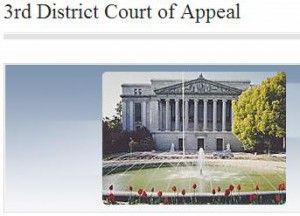High-speed rail opponents file for rehearing

 On Aug. 14, the three litigants in the case to halt California’s high-speed rail project, Kings County and two local residents, filed a Petition for Rehearing. They challenged the July 31 ruling against them by Sacramento’s 3rd District Court of Appeal. The ruling, which reversed a lower-court decision, greenlighted the project.
On Aug. 14, the three litigants in the case to halt California’s high-speed rail project, Kings County and two local residents, filed a Petition for Rehearing. They challenged the July 31 ruling against them by Sacramento’s 3rd District Court of Appeal. The ruling, which reversed a lower-court decision, greenlighted the project.
The rehearing also would be with the 3rd District Court of Appeal.
Depending on the results of the rehearing, Stuart Flashman, the counsel for Kings County and the two residents, said the litigants could file an action with the California Supreme Court by Sept. 2 because of the precedent-setting nature of the arguments the justices made about bond measures in general.
The litigants insisted the Appeals Court decision made factual errors by raising two issues not brought up by the state of California during the trial.
First issue: The litigants said the decision included issues of fact and law that were neither proposed nor briefed by any party to the proceeding. They said, “The court’s decision asserted that the Preliminary Funding Plan was only an ‘interlocutory and preliminary step in a multistep process.’’’
However, according to the litigants, “[T]hat issue had neither been proposed nor briefed by any party.” They cited Government Code Section 68081:
“Before the Supreme Court, a court of appeal, or the appellate division of a superior court renders a decision in a proceeding other than a summary denial of a petition for an extraordinary writ, based upon an issue which was not proposed or briefed by any party to the proceeding, the court shall afford the parties an opportunity to present their views on the matter through supplemental briefing. If the court fails to afford that opportunity, a rehearing shall be ordered upon timely petition of any party.”
Second issue: The litigants said the court decision contained errors in its identification and discussion of facts, which affected the validity of the decision.
They contended that, according the court, “Proposition 1A did not in any way constrain the Legislature’s discretion in approving an appropriation for the high-speed rail project.” In fact, Prop. 1A, the 2008 initiative voters approved for $9 billion in bonds to fund the project, includes many stipulations how the Legislature can spend the bond money.
The litigants also contended that both these points were brought up in court by the justices during the arguments at the May 23, 2014 hearing, with no chance for rebuttal, effectively helping the state’s defense of the high-speed rail spending.
Kenny decision
The decision the 3rd District Court of Appeal overturned was Superior Court Judge Kenny’s remedy decision on Nov. 25, 2013, essentially halted the high-speed rail project. Kenny required the California High-Speed Rail Authority to redo its funding plan because the plan had not followed the “plain language” in the bond measure. The CHSRA had not completed environmental work, nor did it have commitments to fund the first 300 miles of the estimated $68 billion project.
Kenny also ruled in a separate decision that bonds needed for construction could not be allocated since the CHSRA failed to provide evidence to the High Speed Passenger Train Finance Committee that the bonds were necessary or desirable.
Legislature
The 3rd District Court of Appeal also ruled July 31 that, without specific language in a ballot measure that forbade legislative tampering, the appellate court could not interfere with the appropriation process of the Legislature. They said there was no remedy, even though the CHSRA’s Funding Plan did not meet the requirements of the bond measure.
In their final ruling, though, the appeals court offered a window of hope to the litigants, writing that the litigants could protest the final funding plan if it was inadequate. Before spending any Prop. 1A bond funds, the CHSRA is required to have all environmental work completed and funding in place from Madera down to the San Fernando Valley, as well as requiring a financial consultant deem the project viable.
The appeals court also noted, “[T]he voters clearly intended to place the Authority in a financial straight-jacket by establishing a mandatory multi-step process to ensure the financial viability of the project.” So even to the court, it was clear what the voters chose. Despite that, the court said, in effect: It doesn’t matter.
Flashman insisted that, whether the language is explicit or implicit, a bond measure must be honored. He said it is a contract and everybody, the voters and the government, had to agree before any changes were made. That would mean a new ballot measure would be needed to change the project.
He also said that, if this ruling stands, in the future someone with another bond could “intentionally mislead the public or even commit fraud” if the bond measure could easily be changed by the Legislature after voter approval.
The appeals court will have until the end of October to reply to the request for the Petition for Rehearing.
Kathy Hamilton is the Ralph Nader of high-speed rail, continually uncovering hidden aspects of the project and revealing them to the public. She started writing in order to tell local communities how the project affects them and her reach grew statewide. She has written more than 225 articles on high-speed rail and attended hundreds of state and local meetings. She is a board member of the Community Coalition on High-Speed Rail; has testified at government hearings; has provided public testimony and court declarations on public records act requests; has given public testimony; and has provided transcripts for the validation of court cases.
Related Articles
New energy secretary could boost CA oil production
Feb. 8, 2013 By Chriss Street President Obama’s expected naming of Ernest J. Moniz as the next secretary of energy
Workers' Comp officials reprimanded
MAY 13, 2010 By KATY GRIMES Mention workers’ compensation reform in a crowd, and eyes immediately glaze over. It can
CalPERS numbers attract fresh scrutiny
The California Public Employees’ Retirement System looks to see 2015 as another controversial year, especially around four budding controversies. First, attention has



